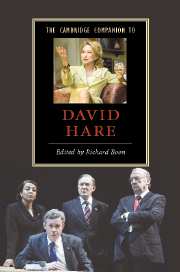Book contents
- Frontmatter
- Introduction
- Part I Text and context
- 1 Portable Theatre: ‘fine detail, rough theatre’
- 2 Keeping turning up
- 3 In opposition
- 4 Hare’s trilogy at the National
- 5 Hare’s ‘stage poetry’, 1995-2002
- 6 ‘Stopping for lunch’
- Part II Working with Hare
- Part III Hare on screen
- Part IV Overviews of Hare
- Selected Bibliography
- Index
5 - Hare’s ‘stage poetry’, 1995-2002
from Part I - Text and context
Published online by Cambridge University Press: 28 April 2008
- Frontmatter
- Introduction
- Part I Text and context
- 1 Portable Theatre: ‘fine detail, rough theatre’
- 2 Keeping turning up
- 3 In opposition
- 4 Hare’s trilogy at the National
- 5 Hare’s ‘stage poetry’, 1995-2002
- 6 ‘Stopping for lunch’
- Part II Working with Hare
- Part III Hare on screen
- Part IV Overviews of Hare
- Selected Bibliography
- Index
Summary
'It is only now . . . that I realise, almost without noticing, that for some time my subject as a playwright has been faith', Hare has written. This has never been more true than for Skylight (1995), Amy's View (1997), My Zinc Bed (2000) and The Breath of Life (2002) - works that, as Richard Boon has observed, 'show a steady progress towards increasingly “private” plays'. Issues of faith are notoriously difficult to deal with on stage, and as a means of approaching them Hare began experimenting with what he himself has called 'stage poetry', a form that enables him to take his audiences to the heart of his characters' spiritual lives without sermonising - in fact, without necessarily using language at all. Besides explaining the themes of these important plays, this essay will unravel the mechanics of Hare's 'stage poetry'.
- Type
- Chapter
- Information
- The Cambridge Companion to David Hare , pp. 79 - 91Publisher: Cambridge University PressPrint publication year: 2007

